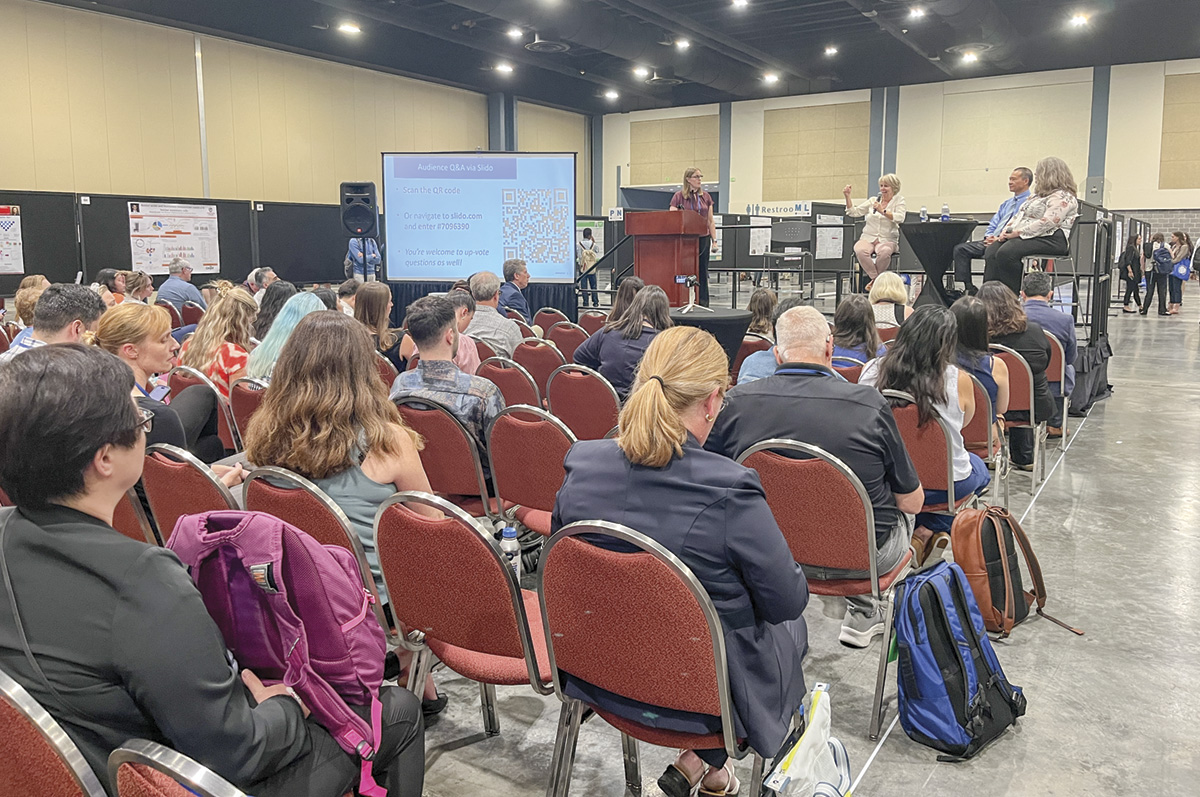It’s been a wild year with weather, and mid-June was no exception. Shortly after news of flooding in south Florida made headlines across the nation, more than 1,700 dairy scientists and industry professionals from across North America and around the globe representing 42 countries convened in West Palm Beach for the 2024 American Dairy Science Association (ADSA) annual meeting. Aside from the 707 research posters presented, 34 symposia, 431 oral presentations, various workshops and other events, attendees enjoyed many opportunities to network with colleagues during the opening reception, breaks, meals and during the ice cream social. Additionally, award winners were recognized during the awards ceremony. The 2025 annual meeting will be held June 22-25 in Louisville, Kentucky.
Below is a summary of two of the 34 symposia along with an overview of key insights shared during a hot topics session on highly pathogenic avian influenza (HPAI) and its recent impact on dairy herds.
Artificial intelligence
During the ADSA Interdisciplinary Symposium focused on the application of artificial intelligence (AI) to dairy systems, speakers explored the current and potential uses for AI in the dairy industry and in dairy science.
Dr. Robin White from Virginia Tech discussed the use of generative AI tools in journal article preparation. She stressed the importance of students and others learning to responsibly use the tools they have access to, including AI. However, she noted the many limitations that may lead to inaccuracies. This is an ongoing discussion at many publications, including the Journal of Dairy Science.
“Where should the line be?” White asked. “I don’t think this type of technology is something we can draw a line with.”
In his presentation titled “Smart cows, smart farms: Unleashing the potential of artificial intelligence in the dairy sector,” Dr. Jeffrey Bewley from Holstein Association USA discussed the need for a balanced approach to AI that considers both the benefits and challenges. AI can be used to optimize crop health, soil conditions and irrigation schedules, as well as in autonomous vehicles, navigation, safety tools and more. On the dairy, wearable sensors, process automation and remote monitoring were highlighted with a focus on improving both animal and farmer well-being.
“When we’re thinking about bringing these technologies to the farm, I think it’s really important to remember that they have to do something meaningful and actionable for the dairy farm itself,” Bewley said.
Beef-on-dairy
Beef-on-dairy continues to gain in popularity among dairy producers as part of their genetics strategy and as a means of diversification. During a joint Canadian Society of Animal Science (CSAS) and ADSA Breeding and Genetics Committee Symposium focused on beef-on-dairy, four presenters addressed animal nutrition, breeding strategies and management related to the challenges and opportunities of utilizing beef-on-dairy.
Among the four presenters was Melissa Bowers, a Canadian dairy producer and vice president of embryos at Boviteq, who brought a producer perspective to the discussion by elaborating further on a variety of reproductive strategies, including IVF, beef-on-dairy, genomic testing, sexed semen, embryos and how the operations she works with across North America are using them.
Among the benefits of incorporating beef genetics into dairy operations is the creation of a new revenue stream while producing a value-added product.
“For us, it’s our 13th milk check,” Bowers said. “We have a Jersey herd, and not that long ago, I used to receive an invoice for Jersey bull calves because they had no value. It actually cost us money to send them to the sale barn, but that has changed. Optimizing resources – better use of your herd and your human resources – to create a value-added product is also a benefit, and we’re able to do this with genetic advancement.”
Bowers recommended that dairy producers who are interested in advancing the reproductive strategies on their own farms, whether that means dabbling in beef-on-dairy or any of the other strategies she discussed, seek out information and learn what works best for their operation through trial and error. Understanding the local market is also key in making those decisions, she said.
“As producers, we have to shift our mindset, and overall, it is shifting,” she said. “Current beef prices are helping as well, but how do we invest the time into looking at that bottom half of our herd the same as we do the top half?”

There was a good turnout at the hot topics panel on HPAI – or H5N1 – on both Monday, June 17 and Tuesday, June 18. Pictured from left to right: moderator Dr. Jessica McArt, editor in chief of JDS Communications from Cornell University; Dr. Pam Ruegg, the College of Veterinary Medicine at Michigan State University; Dr. Steve Zeng, the USDA; and Dr. Nicole Martin from Cornell University. Photo by Kimmi Devaney.
Highly pathogenic avian influenza in dairy herds
There was a good turnout at the hot topics panel on HPAI – or H5N1 – on both Monday, June 17 and Tuesday, June 18. Panelists Dr. Nicole Martin from Cornell University, Dr. Pam Ruegg from the College of Veterinary Medicine at Michigan State University and Dr. Steve Zeng from the USDA answered questions submitted by attendees during these sessions.
Since it was first identified in dairy cattle in March, there have been many questions about how H5N1 continues to impact the dairy industry. Below is an overview of some of the insights shared by panelists during the Q&A session.
“Right now, there are no regulations relative to testing. However, if you see animals that you suspect may be infected and you test or your veterinarian tests, it is a reportable disease.”—Dr. Pam Ruegg
“The CDC has recommendations for PPE that should be used. Work with people where they’re at in their jobs. For the people working in milking parlors, any kind of eye protection is better than nothing. Gloves are also important in various jobs around the farm.”—Dr. Pam Ruegg
“Pasteurization has been effective in maintaining the safety of milk.”—Dr. Nicole Martin
“People and trucks are two potential modes of disease transmission. Right now, the emphasis is on reducing movement, increasing biosecurity, being cleaner, limiting the number of people that come to farms and reducing movement of farmworkers between different farms, and especially between poultry and dairy farms.” —Dr. Pam Ruegg
“The USDA has allocated funding to tackle this issue. We are looking at the holistic, comprehensive ways to stop transmission. We want to stop this infection as soon as possible. We are seeing a lot of funding coming our way and are trying to connect with the industry, farmers, veterinarians, academia and other entities to put together partnerships that can stop the infection.”—Dr. Steve Zeng
“There is anecdotal evidence from talking with vets, nutritionists and farmers about whether youngstock can be affected, but we don’t have a lot of data yet to determine what is correct. There are some farmers who believe their calves have been ill. I’ve heard them describe their calves like kids with the flu. They’ve seen some decreased intakes, some lethargic calves during an outbreak where they’ve confirmed that they’ve had the disease on the farm. So I believe it’s probably likely that there may be some calves affected, but we don’t know for sure yet.”—Dr. Pam Ruegg
“I didn’t believe it when farmers started telling me that some of the worst-affected cows had fevers of 107 or 108 degrees Fahrenheit. You’ll see a dramatic drop in milk production and the milk looks abnormal – more colostrum-like than the consistency of normal milk. It happens in every stage of lactation across the herd in any lactation number, but we tend to see more clinically affected animals that are older. I’ve talked to three farmers who have some type of precision dairy technology on their farms. These farms have alerts for rumination, feed intake, temperatures and more. Often, the first thing they see is that the alerts double or triple. There’s a lot of subclinical animals out there, apparently. I talked to one veterinarian who said he was walking through a group of cows where they had quite a few affected animals – 10 to 15 percent – and he decided to stick thermometers in healthy-looking animals that were up and eating. He said every animal he tested in that pen, even those that appeared to be healthy, had higher-than-expected temperatures. They were around 103, 103 and a half, 104. The other thing that happens universally on farms, we’ve seen a lot of cats die. If you have dead cats and high fevers in your cows, that’s something people are looking at on a very practical basis as an indication of the disease.”—Dr. Pam Ruegg



